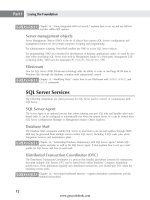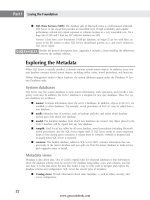Hướng dẫn học Microsoft SQL Server 2008 part 5 pptx
Bạn đang xem bản rút gọn của tài liệu. Xem và tải ngay bản đầy đủ của tài liệu tại đây (1.42 MB, 10 trang )
Nielsen p01.tex V4 - 07/21/2009 11:59am Page 2
www.getcoolebook.com
Nielsen c01.tex V4 - 07/21/2009 11:57am Page 3
The World of SQL Server
IN THIS CHAPTER
Why choose SQL Server?
Understanding the core of SQL
Server: the Relational Database
Engine
Approaching SQL Server
Making sense of SQL Server’s
many services and components
What’s New in SQL Server
2008
W
elcome to SQL Server 2008.
At the Rocky Mountain Tech Tri-Fecta 2009 SQL keynote, I walked through the
major SQL Server 2008 new features and asked the question, ‘‘Cool or Kool-Aid?’’
I’ve worked with SQL Server since version 6.5 and I’m excited about this newest
iteration because it reflects a natural evolution and maturing of the product. I
believe it’s the best release of SQL Server so far. There’s no Kool-Aid here — it’s
all way cool.
SQL Server is a vast product and I don’t know any sane person who claims to
know all of it in depth. In fact, SQL Server is used by so many different types of
professions to accomplish so many different types of tasks, it can be difficult to
concisely define it, but here goes:
SQL Server 2008: Microsoft’s enterprise client-server relational database product,
with T-SQL as its primary programming language.
However, SQL Server is more than just a relational database engine:
■ Connecting to SQL Server is made easy with a host of data connectivity
options and a variety of technologies to import and export data, such
as Tabular Data Stream (TDS), XML, Integration Services, bulk copy,
SQL Native Connectivity, OLE DB, ODBC, and distributed query with
Distributed Transaction Coordinator, to name a few.
■ The engine works well with data (XML, spatial, words within text, and
blob data).
■ SQL Server has a full suite of OLAP/BI components and tools to work
with multidimensional data, analyze data, build cubes, and mine data.
3
www.getcoolebook.com
Nielsen c01.tex V4 - 07/21/2009 11:57am Page 4
Part I Laying the Foundation
■ SQL Server includes a complete reporting solution that serves up great-looking reports, enables
users to create reports, and tracks who saw what when.
■ SQL Server exposes an impressive level of diagnostic detail with Performance Studio, SQL
Trace/Profiler, and Database Management Views and Functions.
■ SQL Server includes several options for high availability with varying degrees of latency,
performance, number of nines, physical distance, and synchronization.
■ SQL Server can be managed declaratively using Policy-Based Management.
■ SQL Server’s Management Studio is a mature UI for both the database developer and the DBA.
■ SQL Server is available in several different scalable editions in 32-bit and 64-bit for scaling up
and out.
All of these components are included with SQL Server (at no additional cost or per-component cost),
and together in concert, you can use them to build a data solution within a data architecture environ-
ment that was difficult or impossible a few years ago. SQL Server 2008 truly is an enterprise database
for today.
A Great Choice
There are other good database engines, but SQL Server is a great choice for several reasons. I’ll leave the
marketing hype for Microsoft; here are my personal ten reasons for choosing SQL Server for my career:
■ Set-based SQL purity: As a set-based data architect type of guy, I find SQL Server fun to
work with. It’s designed to function in a set-based manner. Great SQL Server code has little
reason to include iterative cursors. SQL Server is pure set-based SQL.
■ Scalable performance: SQL Server performance scales well — I’ve developed code on my
notebook that runs great on a server with 32- and 64-bit dual-core CPUs and 48GB of RAM.
I’ve yet to find a database application that doesn’t run well with SQL Server given a good
design and the right hardware.
People sometimes write to the newsgroups that their database is huge — ‘‘over a gig!’’ —but
SQL Server regularly runs databases in the terabyte size. I’d say that over a petabyte is huge,
over a terabyte is large, 100 GB is normal, under 10 GB is small, and under 1 GB is tiny.
■ Scalable experience: The SQL Server experience scales from nearly automated self-managed
databases administered by the accidental DBA to finite control that enables expert DBAs to
tune to their heart’s content.
■ Industry acceptance: SQL Server is a standard. I can find consulting work from small shops
to the largest enterprises running SQL Server.
■ Diverse technologies: SQL Server is broad enough to handle many types of problems and
applications. From BI to spatial, to heavy transactional OLTP, to XML, SQL Server has a
technology to address the problem.
■ SQL in the Cloud: There are a number of options to host a SQL database in the cloud with
great stability, availability, and performance.
■ Financial stability: It’s going to be here for a nice long time. When you choose SQL Server,
you’re not risking that your database vendor will be gone next year.
4
www.getcoolebook.com
Nielsen c01.tex V4 - 07/21/2009 11:57am Page 5
The World of SQL Server 1
■ Ongoing development: I know that Microsoft is investing heavily in the future of SQL Server,
and new versions will keep up the pace of new cool features. I can promise you that SQL 11
will rock!
■ Fun community: There’s an active culture around SQL Server, including a lot of user groups,
books, blogs, websites, code camps, conferences, and so on. Last year I presented 22 sessions
at nine conferences, so it’s easy to find answers and get plugged in. In fact, I recently read a
blog comparing SQL Server and Oracle and the key differentiator is enthusiasm of the commu-
nity and the copious amount of information it publishes. It’s true: the SQL community is a fun
place to be.
■ Affordable: SQL Server is more affordable than the other enterprise database options, and the
Developer Edition costs less than $50 on Amazon.
The Client/Server Database Model
T
echnically, the term
client/server
refers to any two cooperating processes. The client process requests a
service from the server process, which in turn handles the request for the client. The client process and
the server process may be on different computers or on the same computer: It’s the cooperation between the
processes that is significant, not the physical location.
For a client/server database, the client application (be it a front end, an ETL process, a middle tier, or a report)
prepares a SQL request — just a small text message or remote procedure call (RPC) — and sends it to the
database server, which in turn reads and processes the request. Inside the server, the security is checked, the
indexes are searched, the data is retrieved or manipulated, any server-side code is executed, and the final
results are sent back to the client. All the database work is performed within the database server. The actual
data and indexes never leave the server.
In contrast, desktop file-based databases (such as Microsoft Access), may share a common file, but the
desktop application does all the work as the data file is shared across the network.
The client/server–database model offers several benefits over the desktop database model:
■ Reliability is improved because the data is not spread across the network and several
applications. Only one process handles the data.
■ Data integrity constraints and business rules can be enforced at the server level,
resulting in a more thorough implementation of the rules.
■ Security is improved because the database keeps the data within a single server. Hack-
ing into a data file that’s protected within the database server is much more difficult
than hacking into a data file on a workstation. It’s also harder to steal a physical
storage device connected to a server, as most server rooms are adequately protected
against intruders.
■ Performance is improved and better balanced among workstations because the major-
ity of the workload, the database processing, is being handled by the server; the
workstations handle only the user-interface portion.
continued
5
www.getcoolebook.com
Nielsen c01.tex V4 - 07/21/2009 11:57am Page 6
Part I Laying the Foundation
continued
■ Because the database server process has direct access to the data files, and much of
the data is already cached in memory, database operations are much faster at the
server than in a multi-user desktop-database environment. A database server is serving
every user operating a database application; therefore, it’s easier to justify the cost of a
beefier server. For applications that require database access and heavy computational
work, the computational work can be handled by the application, further balancing
the load.
■ Network traffic is greatly reduced. Compared to a desktop database’s rush-hour traffic,
client/server traffic is like a single motorcyclist carrying a slip of paper with all 10
lanes to himself. This is no exaggeration! Upgrading a heavily used desktop database
to a well-designed client/server database will reduce database-related network traffic
by more than 95 percent.
■ A by-product of reducing network traffic is that well-designed client/server appli-
cations perform well in a distributed environment — even when using slower
communications. So little traffic is required that even a 56KB dial-up line should
be indistinguishable from a 100baseT Ethernet connection for a .NET-rich client
application connected to a SQL Server database.
Client/server SQL Server: a Boeing 777. Desktop databases: a toy red wagon.
SQL Server Database Engine
SQL Server components can be divided into two broad categories: those within the engine, and external
tools (e.g., user interfaces and components), as illustrated in Figure 1-1. Because the relational Database
Engine is the core of SQL Server, I’ll start there.
Database Engine
The SQL Server Database Engine, sometimes called the Relational Engine, is the core of SQL Server. It is
the component that handles all the relational database work. SQL is a descriptive language, meaning it
describes only the question to the engine; the engine takes over from there.
Within the Relational Engine are several key processes and components, including the following:
■ Algebrizer: Checks the syntax and transforms a query to an internal representation that is
used by the following components.
■ Query Optimizer: SQL Server’s Query Optimizer determines how to best process the query
based on the costs of different types of query-execution operations. The estimated and actual
query-execution plans may be viewed graphically, or in XML, using Management Studio or
SQL Profiler.
■ Query Engine, or Query Processor: Executes the queries according to the plan generated by
the Query Optimizer.
6
www.getcoolebook.com
Nielsen c01.tex V4 - 07/21/2009 11:57am Page 7
The World of SQL Server 1
■ Storage Engine: Works for the Query Engine and handles the actual reading from and writing
to the disk.
■ The Buffer Manager: Analyzes the data pages being used and pre-fetches data from the data
file(s) into memory, thus reducing the dependency on disk I/O performance.
■ Checkpoint: Process that writes dirty data pages (modified pages) from memory to the data
file.
■ Resource Monitor: Optimizes the query plan cache by responding to memory pressure and
intelligently removing older query plans from the cache.
■ Lock Manager: Dynamically manages the scope of locks to balance the number of required
locks with the size of the lock.
■ SQLOS: SQL Server eats resources for lunch, and for this reason it needs direct control of the
available resources (memory, threads, I/O request, etc.). Simply leaving the resource manage-
ment to Windows isn’t sophisticated enough for SQL Server. SQL Server includes its own OS
layer, SQLOS, which manages all of its internal resources.
SQL Server 2008 supports installation of up to 16 (Workgroup Edition) or 50 (Standard or Enterprise
Edition) instances of the Relational Engine on a physical server. Although they share some components,
each instance functions as a complete separate installation of SQL Server.
FIGURE 1-1
SQL Server is a collection of components within the relational Database Engine and client components.
Internet
ADO.Net
3
rd
party apps
Management Studio
Configuration Manager
Profiler
Books Online
Database Engine Tuning Advisor
System Monitor / PerfMon
HTTP
Web
Services
SQL Agent
Relational
Database
Engine
Service
Broker
Distributed Qs
Replication
Reporting
Services
Integration
Services
Database Mail
Policy-Based
Management
Analysis
Services
Integrated
Full
Text
Search
Query Optimizer
Query Processor
SQLOS
.Net CLR
Storage Engine
7
www.getcoolebook.com
Nielsen c01.tex V4 - 07/21/2009 11:57am Page 8
Part I Laying the Foundation
ACID and SQL Server’s Transaction Log
S
QL Server’s Transaction Log is more than an optional appendix to the engine. It’s integral to SQL Server’s
reputation for data integrity and robustness. Here’s why:
Data integrity is defined by the acronym ACID, meaning transactions must be Atomic (one action — all or
nothing), Consistent (the database must begin and end the transaction in a consistent state), Isolated (no
transaction should affect another transaction), and Durable (once committed, always committed).
The transaction log is vital to the ACID capabilities of SQL Server. SQL Server writes to the transaction log
as the first step of writing any change to the data pages (in memory), which is why it is sometimes called the
write-ahead transaction log
.
Every DML statement (Select, Insert, Update, Delete) is a complete transaction, and the transaction log
ensures that the entire set-based operation takes place, thereby ensuring the atomicity of the transaction.
SQL Server can use the transaction log to roll back, or complete a transaction regardless of hardware failure,
which is key to both the consistency and durability of the transaction.
Chapter 40, ‘‘Policy-Based Management,’’ goes into more detail about transactions.
Transact-SQL
SQL Server is based on the SQL standard, with some Microsoft-specific extensions. SQL was
invented by E. F. Codd while he was working at the IBM research labs in San Jose in 1971. SQL
Server is entry-level (Level 1) compliant with the ANSI SQL 92 standard. (The complete spec-
ifications for the ANSI SQL standard are found in five documents that can be purchased from
www.techstreet.com/ncits.html. I doubt if anyone who doesn’t know exactly what to look for
will find these documents.) But it also includes many features defined in later versions of the standard
(SQL-1999, SQL-2003).
While the ANSI SQL definition is excellent for the common data-selection and data-definition
commands, it does not include commands for controlling SQL Server properties, or provide the
level of logical control within batches required to develop a SQL Server–specific application.
Therefore, the Microsoft SQL Server team has extended the ANSI definition with several enhance-
ments and new commands, and has left out a few commands because SQL Server implemented
them differently. The result is Transact-SQL, or T-SQL — the dialect of SQL understood by
SQL Server.
Missing from T-SQL are very few ANSI SQL commands, primarily because Microsoft implemented the
functionality in other ways. T-SQL, by default, also handles nulls, quotes, and padding differently than
the ANSI standard, although that behavior can be modified. Based on my own development experience,
I can say that none of these differences affect the process of developing a database application using SQL
Server. T-SQL adds significantly more to ANSI SQL than it lacks.
8
www.getcoolebook.com
Nielsen c01.tex V4 - 07/21/2009 11:57am Page 9
The World of SQL Server 1
Understanding SQL Server requires understanding T-SQL. The native language of the SQL Server
engine is Transact-SQL. Every command sent to SQL Server must be a valid T-SQL command.
Batches of stored T-SQL commands may be executed within the server as stored procedures. Other
tools, such as Management Studio, which provide graphical user interfaces with which to control
SQL Server, are at some level converting most of those mouse clicks to T-SQL for processing by
the engine.
SQL and T-SQL commands are divided into the following three categories:
■ Data Manipulation Language (DML): Includes the common SQL
SELECT, INSERT,
UPDATE,andDELETE commands. DML is sometimes mistakenly referred to as Data Modifica-
tion Language; this is misleading, because the
SELECT statement does not modify data. It does,
however, manipulate the data returned.
■ Data Definition Language (DDL): Commands that
CREATE, ALTER,orDROP data tables,
constraints, indexes, and other database objects.
■ Data Control Language (DCL): Security commands such as
GRANT, REVOKE,andDENY that
control how a principal (user or role) can access a securable (object or data.)
In Honor of Dr. Jim Gray
J
im Gray, a Technical Fellow at Microsoft Research (MSR) in San Francisco, earned the ACM Turing
Award in 1998 ‘‘for seminal contributions to database and transaction processing research and technical
leadership in system implementation.’’
A friend of the SQL Server community, he often spoke at PASS Summits. His keynote address on the future of
databases at the PASS 2005 Community Summit in Grapevine, Texas, was one of the most thrilling database
presentations I’ve ever seen. He predicted that the exponential growth of cheap storage space will create a
crisis for the public as they attempt to organize several terabytes of data in drives that will fit in their pockets.
For the database community, Dr. Gray believed that the growth of storage space would eliminate the need
for updating or deleting data; future databases will only have insert and select commands.
The following image of Microsoft’s TerraServer appeared in the SQL Server 2000 Bible. TerraServer was
Microsoft’s SQL Server 2000 scalability project, designed by Jim Gray. His research in spatial data is behind
the new spatial data types in SQL Server 2008.
Dr. Gray’s research led to a project that rocked the SQL world: 48 SATA drives were configured to build a
24-TB data warehouse, achieving throughputs equal to a SAN at one-fortieth the cost.
On January 28, 2007, Jim Gray disappeared while sailing alone near the Farallon Islands just outside San
Francisco Bay. An extensive sea search by the U.S. Coast Guard, a private search, and an Internet satellite
image search all failed to reveal any clues.
continued
9
www.getcoolebook.com
Nielsen c01.tex V4 - 07/21/2009 11:57am Page 10
Part I Laying the Foundation
continued
Policy-Based Management
Policy-based management, affectionately known as PBM, and new for SQL Server 2008, is the system
within the engine that handles declarative management of the server, database, and any database object.
As declarative management, PBM replaces the chaos of scripts, manual operations, three-ring binders
with daily run sheets and policies, and Post-it notes in the DBA’s cubicle.
Chapter 40, ‘‘Policy-Based Management,’’ discusses managing your server declaratively.
.NET Common Language Runtime
Since SQL Server 2005, SQL Server has hosted an internal .Net Common Language Runtime, or CLR.
Assemblies developed in Visual Studio can be deployed and executed inside SQL Server as stored proce-
dures, triggers, user-defined functions, or user-defined aggregate functions. In addition, data types devel-
oped with Visual Studio can be used to define tables and store custom data.
SQL Server’s internal operating system, SQLOS, actually hosts the .NET CLR inside SQL Server. There’s
value in SQLOS hosting the CLR, as it means that SQL Server is in control of the CLR resources. It can
prevent a CLR problem, shut down and restart a CLR routine that’s causing trouble, and ensure that the
battle for memory is won by the right player.
While the CLR may sound appealing, Transact-SQL is the native language of SQL Server and it performs
better and scales better than the CLR for nearly every task. The CLR is useful for coding tasks that
10
www.getcoolebook.com
Nielsen c01.tex V4 - 07/21/2009 11:57am Page 11
The World of SQL Server 1
require resources external to the database that cannot be completed using T-SQL. In this sense, the CLR
is the replacement for the older extended stored procedures. In my opinion, the primary benefit of the
CLR is that Microsoft can use it to extend and develop SQL Server.
By default, the common language runtime is disabled in SQL Server and must be specifically enabled
using a T-SQL
SET command. When enabled, each assembly’s scope, or ability to access code outside
SQL Server, can be carefully controlled.
.NET integration is discussed in Chapter 32, ‘‘Programming .NET CLR within SQL Server.’’
Service Broker
Introduced in SQL Server 2005, Service Broker is a managed data queue, providing a key performance
and scalability feature by leveling the load over time:
■ Service Broker can buffer high volumes of calls to an HTTP Web Service or a stored pro-
cedure. Rather than a thousand Web Service calls launching a thousand stored procedure
threads, the calls can be placed on a queue and the stored procedures can be executed by a
few instances to handle the load more efficiently.
■ Server-side processes that include significant logic or periods of heavy traffic can place the
required data in the queue and return to the calling process without completing the logic.
Service Broker will move through the queue calling another stored procedure to do the heavy
lifting.
While it’s possible to design your own queue within SQL Server, there are benefits to using Microsoft’s
work queue. SQL Server includes DDL commands to manage Service Broker, and there are T-SQL
commands to place data on the queue or fetch data from the queue. Information about Service Broker
queues are exposed in metadata views, Management Studio, and System Monitor. Most important,
Service Broker is well tested and designed for heavy payloads under stress.
Service Broker is a key service in building a service-oriented architecture data store. For
more information, see Chapter 35, ‘‘Building Asynchronous Applications with Service
Broker.’’
Replication services
SQL Server data is often required throughout national or global organizations, and SQL Server replica-
tion is often employed to move that data. Replication Services can move transactions one-way or merge
updates from multiple locations using a publisher-distributor-subscriber topology.
Chapter 36, ‘‘Replicating Data,’’ explains the various replication models and how to set up
replication.
Integrated Full-Text Search
Full-Text Search has been in SQL Server since version 7, but with each version this excellent service has
been enhanced, and the name has evolved to Integrated Full-Text Search, or iFTS.
SQL queries use indexes to locate rows quickly. SQL Server b-tree indexes index the entire column.
Searching for words within the column requires a scan and is a very slow process. Full-Text Search
solves this problem by indexing every word within a column.
Once the full-text search has been created for the column, SQL Server queries can search the Full-Text
Search indexes and return high-performance in-string word searches.
11
www.getcoolebook.com









